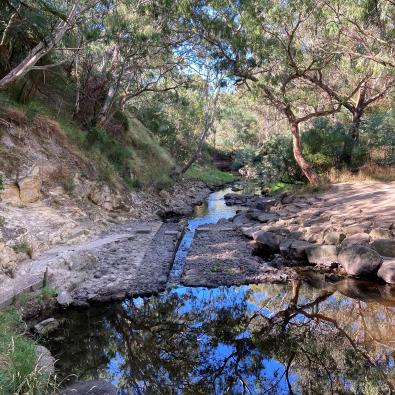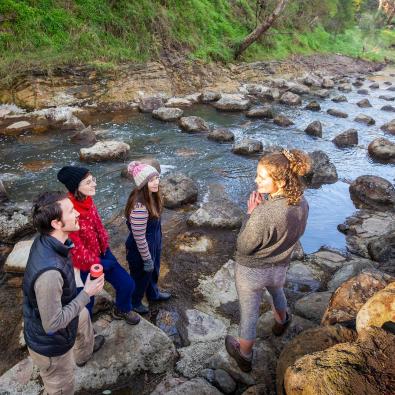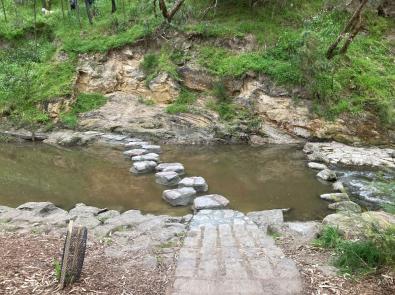“The health of our waterways is integral in protecting our natural environment, including plants and animals. The fish ladder helps fish like the Common Galaxias and Short Finned Eel to finish their lifecycle as they travel from saltwater environments to fresh water environments, creating healthier fish populations and ecosystems.”
– Rob Considine, Melbourne Water
Engineering for biodiversity
Carried out by Melbourne Water, the $350,000 project involved installing a series of carefully designed rock works placed downstream of the structure in Darebin Parklands.
This ‘rock ramp fishway’ allows water to cascade through the structure forming eddies that act as a refuge for fish so they can move freely through the waterway. The design targets fish species that migrate from saltwater to freshwater environments to complete their life cycle including Common Galaxias and Short Finned Eel.
The fish ladder was constructed with imported locally sourced rock. The project was constructed on site where materials were matched to compliment the natural waterway and the environment.
Construction involved:
- approximately 500 tonnes of rock
- multiple stages or step levels (11 in total)
- bypassing all the water in the creek during construction (around 30 ML per day)
Stepping stones were also installed and optimised to make it safer for people to cross the creek.
Connectivity in action
In December 2022, Arthur Rylah Institute recorded native fish species upstream of the newly constructed Darebin Creek fish ladder.
To assess the function of the fish ladder monitoring was scheduled before and after construction during Spring and early Summer when important fish migrations occur. Fish were recorded using electrofishing and fyke netting at eight sites located both up and downstream of the fish ladder.
Exciting early results show that the fishway is already helping fish to move upstream. Importantly, small, young fish were also able to navigate through the fish ladder. Common galaxias were commonly found upstream of the newly constructed fish ladder and there were no congregations of fish found downstream, showing that the fish ladder is no longer acting as a barrier to fish migration.
In total, nine species of fish were collected including five species of native fish and four species of introduced fish. Spot water quality measurements including Electrical conductivity (EC), Dissolved Oxygen (DO), pH, turbidity and water temperature were also taken at each site and all of these fell within the expected range for Darebin Creek.
| Species | Abundance upstream of fish ladder | Abundance downstream of fish ladder | |
|---|---|---|---|
| Native | Common galaxias | 57 | 2 |
| Native | Flat headed gudgeon | 3 | |
| Native | Short finned eel | 40 | 6 |
| Invertebrate | Lowland burrowing crayfish | 4 | |
| Invertebrate | Paratya | 35 | 6 |
Removing fish barriers improves instream connectivity so that fish can move freely along Darebin Creek from the confluence with the Yarra River to the upper reaches of Darebin Creek.
Arthur Rylah Institute will undertake further monitoring in future to help us understand the status of the Darebin Creek fish community and their movements.
“This is connectivity in action – we connect the creek, we connect people with the creek, and we connect people with people who love the creek.”
– Dr Graeme Hamilton, Darebin Creek Management Committee Inc.
The success of the Darebin Creek Fish ladder is a result of the collaboration between Melbourne Water, Arthur Rylah Institute, Greenworks, Darebin Creek Management Committee and Darebin Parklands Association.
More information
Links to the Healthy Waterways Strategy
The project is part of the Co-Designed Catchment Program that delivers the 2018-28 Healthy Waterways Strategy by providing habitat connectivity for fish along major waterways.


